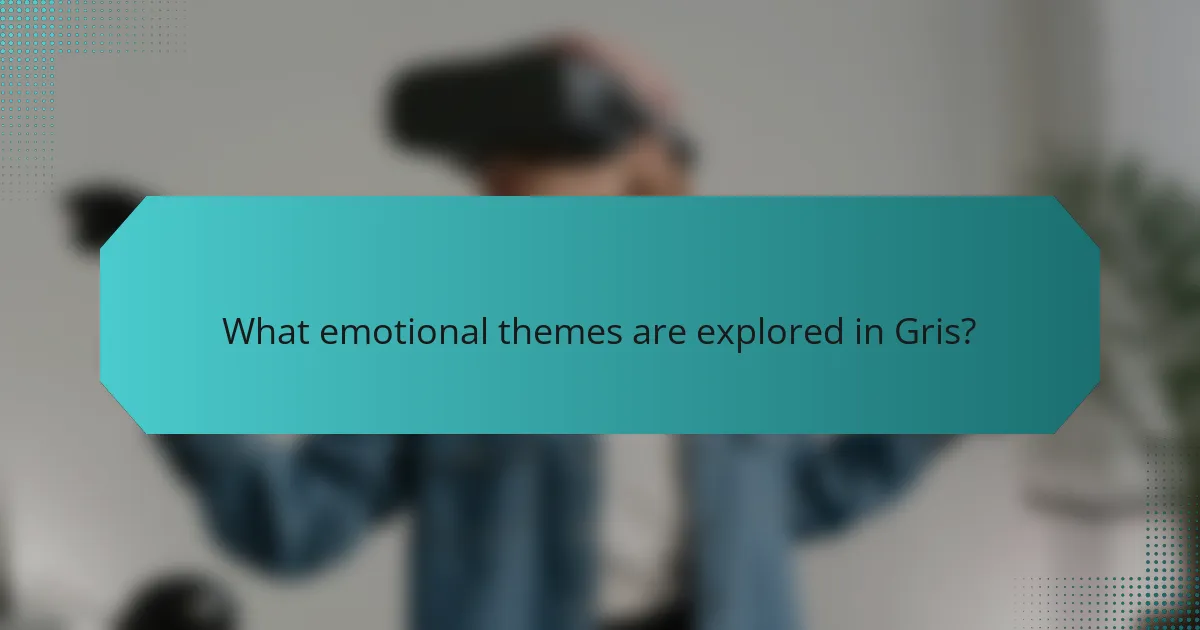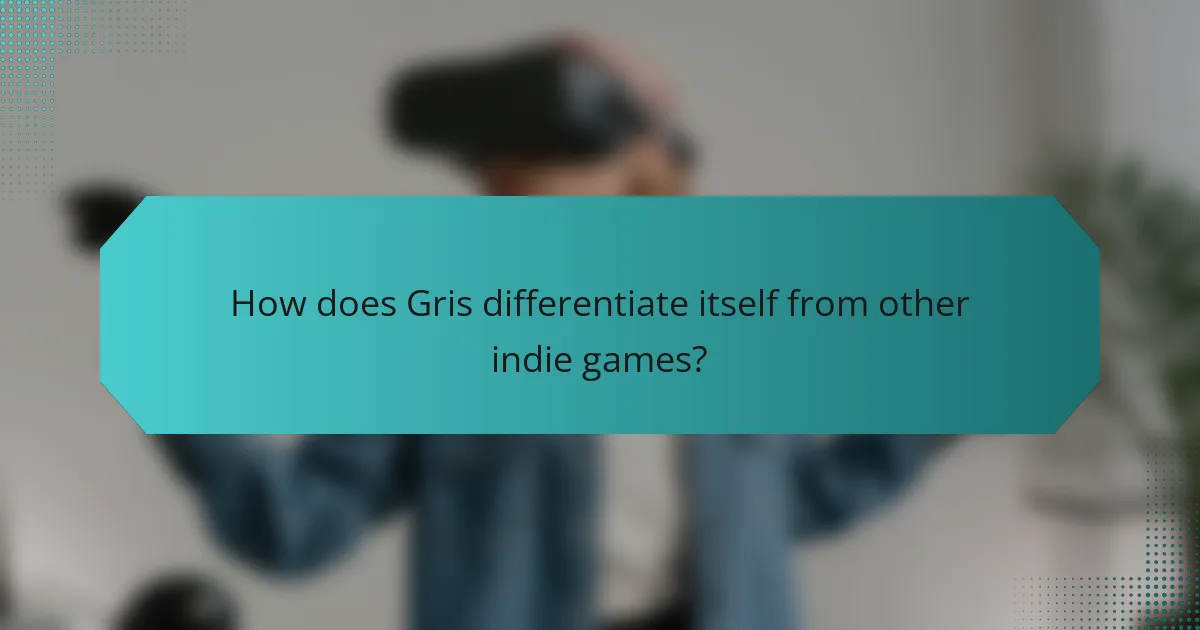Discover how “Gris” captivates players through its stunning visual aesthetics, immersive sound design, and profound emotional resonance. The game features watercolor-inspired art and vibrant colours that enhance storytelling. Its sound design complements the visuals, creating a rich atmosphere. Together, these elements explore themes of grief, loss, and self-discovery, inviting players to connect deeply with the narrative.

What are the key visual aesthetics of Gris?
Gris features a unique visual aesthetic characterised by watercolor-inspired art, vibrant colours, and fluid animations. The game employs a minimalist design that enhances emotional storytelling, creating a dreamlike atmosphere. Each level showcases distinct colour palettes that represent different emotional states, reinforcing the game’s themes of loss and recovery. The seamless transitions between scenes contribute to the immersive experience, making the visuals an integral part of the narrative.
How does colour palette influence player emotions?
Colour palettes significantly influence player emotions by evoking specific feelings and enhancing the overall gaming experience. In “Gris,” the use of vibrant colours and subtle gradients creates a visual narrative that resonates emotionally with players. For instance, warm colours may evoke feelings of joy, while cooler tones can induce melancholy. The game’s colour transitions mirror the protagonist’s emotional journey, reinforcing themes of loss and recovery. This intentional design choice cultivates a deeper connection between the player and the game, demonstrating the power of visual aesthetics in shaping emotional resonance.
What role does animation play in storytelling?
Animation enhances storytelling by visually expressing emotions, themes, and narratives that resonate deeply with audiences. In “Gris,” the visual aesthetics use colour and form to reflect the protagonist’s journey, while sound design amplifies emotional impact. This synergy creates a rich narrative experience, allowing players to connect with the character’s struggles and triumphs on a profound level. The unique attribute of “Gris” lies in its ability to convey complex emotions without dialogue, showcasing animation’s power in storytelling.
Which visual motifs are prevalent throughout the game?
Gris features several prevalent visual motifs that enhance its emotional depth. The use of colour gradients symbolises character development, while organic shapes evoke fluidity and transformation. The interplay of light and shadow creates a dreamlike atmosphere, reinforcing themes of loss and hope. Additionally, recurring motifs like birds and flowers signify freedom and growth throughout the game. These visual elements collectively contribute to the game’s narrative and emotional resonance.

How is sound design integrated into the gameplay experience?
Sound design is integral to gameplay in “Gris” as it enhances emotional storytelling and player immersion. The auditory elements, including music and sound effects, create a rich atmosphere that complements the visual aesthetics. This synergy between sound and visuals deepens the player’s emotional connection, guiding them through the game’s narrative journey. Unique soundscapes evolve with gameplay, reflecting character emotions and environmental changes, thereby enriching the overall experience.
What techniques are used to create an immersive audio landscape?
Gris employs techniques like layered soundscapes, dynamic audio cues, and spatial audio to create an immersive audio landscape. Layered soundscapes enhance emotional depth, while dynamic audio cues respond to player actions, enriching the gameplay experience. Spatial audio techniques provide a sense of directionality, allowing players to feel immersed in the environment. These elements work together to evoke strong emotional resonance throughout the game.
How does the soundtrack enhance emotional impact?
The soundtrack significantly enhances emotional impact by creating an immersive atmosphere. It complements the visual aesthetics, guiding players through the protagonist’s journey. The music’s dynamic shifts evoke feelings of joy, sorrow, and introspection, aligning closely with the game’s visual storytelling. Unique sound motifs represent specific emotions, reinforcing the narrative and deepening player engagement.
Which sound effects contribute to gameplay mechanics?
Sound effects in “Gris” significantly enhance gameplay mechanics by providing auditory cues that guide player actions. These effects create emotional depth, influencing player engagement and immersion. For instance, the sound of footsteps varies with terrain, signalling movement and interaction. Additionally, ambient sounds reflect the game’s atmosphere, reinforcing narrative elements. Unique sound design elements, like the use of silence, heighten tension during pivotal moments, making the experience more impactful. Overall, sound effects are integral to gameplay, shaping both mechanics and emotional responses.

What emotional themes are explored in Gris?
Gris explores themes of grief, loss, and self-discovery through its visual and auditory elements. The game’s colour palette transitions symbolise emotional stages, while the music enhances the narrative depth. Each level reflects unique emotional states, such as sadness and joy, creating a resonant experience. The integration of visual aesthetics and sound design amplifies the emotional journey, inviting players to connect deeply with the protagonist’s struggles.
How do the game’s visuals and sound evoke specific feelings?
Gris uses visuals and sound to create a profound emotional experience. The game’s watercolor art style evokes feelings of nostalgia and tranquility, while its dynamic sound design enhances emotional depth. The interplay between the soft, muted colours and the haunting melodies invites players to engage with their inner emotions. Unique attributes, such as the gradual transition of colours reflecting the protagonist’s journey, further intensify the emotional resonance, making each moment impactful.
Which narrative elements support emotional resonance?
Gris employs visual aesthetics, sound design, and narrative structure to evoke emotional resonance. The game’s art style, characterised by watercolor visuals, creates a dreamlike atmosphere that enhances emotional depth. Sound design, including a haunting score, complements visual elements, reinforcing the player’s emotional journey. The narrative unfolds through gameplay mechanics, allowing players to experience emotions without explicit dialogue, fostering a deep connection with the character’s struggles and triumphs. This combination of elements creates a powerful emotional impact, making Gris a unique experience in interactive storytelling.
What are the player responses to emotional moments?
Players respond to emotional moments in “Gris” through heightened engagement and introspection. The game’s visual aesthetics evoke deep feelings, enhancing players’ connection to the narrative. Sound design amplifies emotional resonance, creating a layered experience. Players often report experiencing catharsis during pivotal scenes, illustrating how the game’s design effectively elicits emotional responses. The unique combination of art and sound fosters a memorable journey, reinforcing the emotional impact throughout gameplay.

How does Gris differentiate itself from other indie games?
Gris differentiates itself from other indie games through its unique visual aesthetics, immersive sound design, and profound emotional resonance. The game’s art style features watercolor-inspired visuals that create a dreamlike atmosphere. Each level represents a different emotional state, enhancing player engagement. The sound design complements the visuals with a hauntingly beautiful score that evokes deep feelings. This combination of elements fosters a unique gaming experience, setting Gris apart from typical indie titles.
What unique artistic choices set Gris apart?
Gris stands out due to its unique blend of watercolor-inspired visuals, immersive sound design, and profound emotional storytelling. The game’s aesthetic employs a muted colour palette that evolves with the protagonist’s journey, creating a visual narrative that resonates deeply with players. Sound design enhances this experience, using ambient music and subtle sound effects to evoke emotions tied to each environment. This combination fosters an emotional connection that is rare in the gaming landscape, making Gris a distinctive artistic achievement.
How does the game’s emotional storytelling compare to similar titles?
Gris’s emotional storytelling excels through its unique visual aesthetics and sound design, creating a profound experience. Compared to titles like Journey and Ori and the Blind Forest, Gris emphasises subtlety and abstraction. The game’s art style evokes feelings of melancholy and hope, while the soundtrack enhances emotional depth. This combination fosters a unique emotional resonance, distinguishing it from similar narrative-driven games.
Which aspects of Gris have been recognized by critics?
Critics have recognized Gris for its stunning visual aesthetics, innovative sound design, and profound emotional resonance. The game’s art style features vibrant colours and fluid animations, creating an immersive experience. Sound design complements visuals, enhancing emotional depth through a carefully curated score. Critics highlight how these elements work together to evoke feelings of loss and hope, making Gris a unique artistic achievement in gaming.

What are the best practices for experiencing Gris?
To fully experience Gris, immerse yourself in its visual aesthetics, sound design, and emotional resonance. Focus on these best practices:
1. Engage with the art style. Observe the vibrant colours and fluid animations that enhance emotional depth.
2. Listen attentively to the soundtrack. The music complements the narrative and elevates the overall experience.
3. Embrace the narrative flow. Allow the game to guide your emotions through its storytelling.
4. Take your time. Explore each environment thoroughly to appreciate the intricate details and hidden elements.
How can players maximize their emotional connection to the game?
Players can maximize their emotional connection to “Gris” by engaging deeply with its visual aesthetics and sound design. The game’s hand-painted art style creates a unique atmosphere that evokes feelings of nostalgia and wonder. Each colour and visual element corresponds to specific emotions, enhancing the player’s experience.
Sound design plays a crucial role in this connection. The score, composed by Berlinist, complements the visuals and reinforces emotional moments throughout the gameplay. Players should immerse themselves fully in both the visuals and audio, allowing these elements to resonate personally.
Additionally, taking time to explore the game’s environments can deepen emotional engagement. Observing details in the art and reflecting on the narrative themes can foster a stronger bond with the game. By embracing these aspects, players can cultivate a profound emotional connection to “Gris.”
What tips do experts recommend for new players?
Experts recommend that new players immerse themselves in the visual aesthetics and sound design of “Gris” to enhance their emotional experience. Understanding the game’s artistic style can deepen engagement. Players should explore each scene thoroughly to appreciate the intricate details and emotional nuances. Additionally, experimenting with different gameplay approaches can lead to unique discoveries and personal connections to the narrative. Engaging with community discussions can provide insights and enrich the overall experience.
Which common mistakes should players avoid?
Players should avoid common mistakes that detract from the immersive experience of “Gris.” Focusing too much on completion can overshadow the game’s emotional narrative. Ignoring the visual storytelling may lead to missing crucial themes. Rushing through levels prevents players from fully appreciating the sound design that enhances emotional resonance. Engaging with the environment and taking time to explore enriches the overall experience, allowing players to connect with the game’s artistic vision.